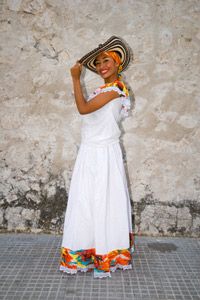Traditional Colombian Clothing
Today, most Colombians wear Western-style clothing. Urban professionals from the Andean interior tend toward conservative, dark-colored suits, while farmers and members of the lower classes prefer loose skirts or pants [source: Árquez and Roadfield]. Modern dress in Colombia’s coastal regions is a little more free-wheeling, with loose-fitting styles and bright colors or prints that reflect the region’s Caribbean influences.
During national festivals like the Carnaval de Barranquilla however, Colombia's traditional fashions take center stage. La Pollera Colora ("brightly colored skirt") is probably Colombia's most well-known national costume for women. It consists of a vividly colored skirt paired with a matching, round-necked blouse, which bares (or partially reveals) the shoulders. Ruffles and lace line the neck and knee lines, and designs range from horizontal bands of brightly contrasting colors to intricate floral or native prints. For parades and performances, men don similar outfits -- matching pants ruffled at the ankle, vivid capes and elaborate headdresses.
Advertisement
One piece of traditional Colombian clothing that's still a common piece of everyday wear, especially in the cooler Andean regions, is the ruana (cape.) Something like a cross between a shawl and a Mexican poncho, the Colombian ruana is a wide swath of cloth wrapped around both shoulders, or wrapped around one shoulder and loosely draped over the other. Colombian farmers and tradesmen of both genders wear ruanas made of primitive, undyed wool. Andean city folk attire themselves in highly fashionable ruanas in any number of styles and fabrics.
Another traditional Colombian fashion still favored by Colombian men today is the sombrero vueltiao. Originally a rustic headpiece worn by peasants, today the sombrero vueltiao is one of Colombia’s national symbols. The term sombrero vueltiao loosely translates as “turned hat.” Handcrafted out of natural palm fibers using a traditional Zenú technique, these sombreros can be beautiful pieces of textile art, depicting religious scenes or everyday activities like hunting and fishing [source: ProExport Colombia].
The sombrero vueltiao, as well as many traditional Colombian textiles, are on display at the Museo de Trajes Regionales de Colombia (Museum of Regional Colombian Costumes) in Bogotá. However, Colombia’s endlessly colorful festivals (which we mentioned above) are the best places to view traditional Colombian fashions, as well as to experience Colombian music and dance.
Hold on to your sombreros, folks; we'll talk about cumbia, currulao and bambuco in the next section.
